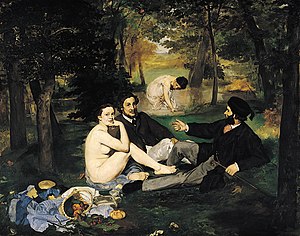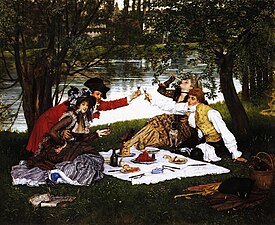Breakfast in the countryside (Manet)

|
| Breakfast in the countryside |
|---|
| Édouard Manet , 1863 |
| Oil on canvas |
| 208 x 264.5 cm |
| Musée d'Orsay |
The breakfast in the green ( French Le Déjeuner sur l'herbe ), originally "The Bath" (French Le bain ), is a painting by the French painter Édouard Manet . The painting, which is 208 cm high and 264.5 cm wide, was created in 1863. It can be viewed today in the Musée d'Orsay in Paris.
background
Manet offered the painting to the Paris Salon for exhibition in 1863 . It was promptly rejected by the 40 jurors. A naked woman sitting with two clothed men was a daring, downright outrageous motif. Only “decent” pictures were hanging in the salon. But Manet was not the only painter who had been rejected. As every year, the rejected protested publicly and something unexpected happened: Emperor Napoléon III. personally instructed that the paintings and sculptures rejected by the Paris Salon be shown in a separate part of the exhibition. This is how The Breakfast in the Green came to the Salon des Refusés and thus finally to the public. The audience reacted irritatedly with scorn, laughter and hostility to the work of art. Last but not least, this reaction of the masses can be attributed to the presentation: The Salon des Refusés could be entered via a turnstile, which at the time was reminiscent of a cabinet of curiosities, as we knew it from fairs. The pictures were also hung in a provocative way: the innumerable pictures almost completely filled the walls up to the ceiling.
The paintings
Antonin Proust , a friend of the painter, reports on the reason for the idea to paint the picture. He and Manet had made a trip to the banks of the Seine in Argenteuil , a place near Paris , on a beautiful summer day :
“Women bathed, Manet looked spellbound at the flesh of those who got out of the water. 'It seems,' he said to me, 'that I have to paint a nude. Well, I'll do them an act. I'm going to be torn apart . You should say what you want! '"
The picture almost explains itself: Two women are having a picnic with their lovers. The title La Partie carrée, originally devised by Manet , makes the intention that the work expresses even clearer.
Manet conceived the remains of breakfast as still life , a subject that had gone out of fashion in its time and was even viewed with contempt. The two gentlemen in the picture are known by name: one is Manet's brother Eugène , the other is the sculptor Ferdinand Leenhoff, his later brother-in-law. The woman in the foreground is Victorine Meurent .
The model for the composition was the painting “ Judgment of Paris ” (Giudizio di Paride) by the Renaissance painter Raffael , which Manet knew from a copy by the engraver Marcantonio Raimondi .
An earlier, smaller, more loosely executed version of the painting is in the Courtauld Gallery , London .
Marcantonio Raimondi
judgment of ParisAntoine Watteau
La Partie CarréeJames Tissot
La Partie Carrée
reception
Jules Champfleury wrote in a letter to Charles Baudelaire in 1865:
"Like a man who falls in the snow, Manet has left a hole in public opinion."
- In 1865, the impressionist Claude Monet began his own breakfast in the country in response to Manet's picture . However, the picture with the dimensions 4.6 by 6 meters remained unfinished. Monet made the scene more acceptable to the bourgeoisie by not including nude models in the picture.
- Émile Zola, a friend of Manet and already a distinguished writer at the time, made clear reference to the painting in his novel L'Œuvre (Eng. The Work ), but in a fictionalized framework.
- A century later, in 1961, Pablo Picasso set out to satirize this modern art icon and within two years created 27 paintings, 6 linocuts and 140 drawings based on this motif.
- In 1964, the French artist Alain Jacquet created a screen-printed parody.
- The cover of the 1979 album Thanks I'll Eat It Here by Lowell George adapted the image. Instead of the people actually depicted, Bob Dylan , Marlene Dietrich as The Blue Angel and Fidel Castro sit together. They have a copy of Howl with them .
- In 1981 a record cover by the British band Bow Wow Wow appeared with a photo in which the band members re- enact breakfast in the countryside .
- In 1994 the American J. Seward Johnson, Jr. created a three-dimensional representation with the title Déjeuner déjà vu .
- Since 2006, an oversized representation of the central group of figures has adorned the textile facade of the “ Weimar Atrium ”, a shopping center on the edge of Weimar city center.
- In the spring / summer 2011 collection, the image was chosen as an inspiration by the Italian designers Dolce & Gabbana. Among other things, it can be found as a print on several T-shirts
- Jimmie Durham quoted the painting as part of dOCUMENTA (13) when designing the label for an apple juice bottle.
literature
- Rose-Marie Hagen, Rainer Hagen: Masterpieces in detail. Image surveys . Taschen, Cologne 2000. ISBN 3-8228-6384-X .
- Michael Lüthy: Image and look in Manet's painting . Gebrüder Mann, Berlin 2003, ISBN 3-7861-1897-3 (Dissertation University of Basel 2000, 261 pages, table of contents and introduction )
- Gerd Blum: “Édouard Manet: Le Déjeuner sur l'herbe. The invention of modernity from the past. ”In: Reingard M. Nischik, Caroline Rosenthal (ed.): Schwellentexte der Weltliteratur , Konstanz: Universitätsverlag 2001, pp. 201–232> online via arthistoricum.net
- Wieland Schmied (Ed.): Harenberg - Museum of Painting. 525 masterpieces from seven centuries , Harenberg, Dortmund 1999, ISBN 3-611-00814-1 .
- Beatrix Ahrens: The "Déjeuner" painting by Edouard Manet, Claude Monet and Pierre-Auguste Renoir. Investigation of the representation of meals in the time of French Impressionism (= series of writings on art history . Volume 20 ). Kovac, Hamburg 2008, ISBN 978-3-8300-3651-7 (dissertation University of Freiburg im Breisgau 2007, 293 pages).
- Hans Körner: Disgusting nudity. “Breakfast in the open” and the “ Olympia ” by E. Manet, in: Karl Möseneder (Ed.) Dispute about images. From Byzantium to Duchamp . Reimer, Berlin 1997, ISBN 3-496-01169-6 , pp. 181-199 and color table 7
Web links
- Peter Kropmanns: Edouard Manet - The breakfast in the country. In: weltkunst.de . January 24, 2018 .
supporting documents
- ↑ Catalog des œuvres - Edouard Manet: Le déjeuner sur l'herbe. Notice de l'œuvre. Musée d'Orsay , accessed October 6, 2018 (French).
- ↑ Description of the work - Edouard Manet: Breakfast in the Green. Musée d'Orsay , accessed October 6, 2018 .
- ↑ Juliet Wilson Bareu: The Salon des Refuses of 1863. A new view. In: The Burlington Magazine, Vol. 149 (2007), No. 1250, pp. 309-319, ISSN 0007-6287
- ^ Antonin Proust: Edouard Manet. Souvenirs. Paris: Laurens 1913. p. 43.
- ↑ Figure and data at www.artandarchitecture.org.uk
- ↑ Schmied: Harenberg Museum of Painting
- ↑ Juliet Wilson Bareu: The Salon des Refuses of 1863. A new view. In: The Burlington Magazine , Vol. 149 (2007), No. 1250, pp. 309-319, ISSN 0007-6287
- ↑ Les “années Jacqueline”. Musée national Picasso Paris , archived from the original on January 21, 2009 ; Retrieved January 21, 2009 .
- ^ Alain Jacquet - Luncheon on the Grass. In: art net. Retrieved September 12, 2015 ( Alain Jacquets screen print ).
- ^ Grounds for Sculpture: An Art-Full Garden. In: Washington Home & Garden. Archived from the original on October 9, 2007 ; Retrieved October 9, 2007 (article on J. Seward Johnson, Jr. three-dimensional representations).





